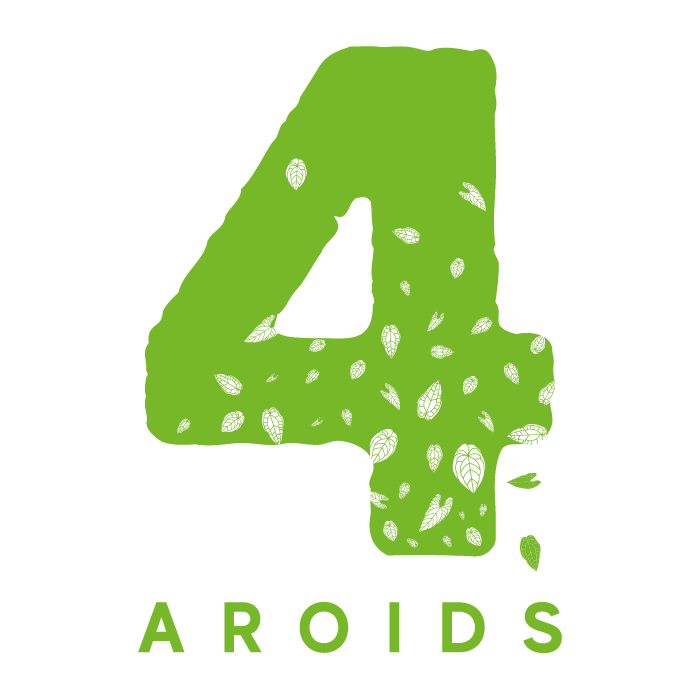As Anthurium besseae aff. are basically anthuriums that are similar to Anthurium besseae, but cannot be definitely assigned to the same species. For a more precise explanation of the term “aff.”
In the hobby the term or species is Anthurium besseae aff. but to be understood a little more specifically. These are plants that are sold under this name, particularly by Ecuadorian nurseries. Whether the name Anthurium besseae aff. is justified from a scientific point of view or whether another name would not have been more appropriate is debatable.
Ultimately, it is now at least agreed that when this name is used, a specific plant or group of plants is meant. But why group?
To do this, you have to take a look at the history of this species name. When larger Ecuadorian breeders released plants under this name in 2021, they were usually plants that were very similar to Anthurium crystallinum, but differed from it in certain properties.
What they both have in common are the striking veins with a silvery double contour, the dark, velvety leaf surface and a fundamentally heart-shaped leaf shape. But the differences are also worth mentioning. How to draw Anthurium besseae aff. in particular the oily, dark blue new leaves, the greenish-yellow rather than white veins and the often slightly darker base color of the leaves when cured. The leaf shape of Anthurium besseae aff is also different. significantly more variable. For example, there are plants with very wide sinus, very elongated leaf shapes or special vein variations, which are not found in Anthurium crystallinum.
Some special clones of Anthurium besseae aff. It has even achieved a certain level of fame under its own form names, such as 'Turtleback', 'Narrow', 'Flat Sinus', 'Spider' or 'Blackbird'.
Anthurium crystallinum has a generally rather homogeneous heart-shaped leaf shape with a narrow sinus, which can occasionally even be closed a few centimeters above the petiole insertion. The inflorescence also differs between the two species mentioned. The inflorescence of Anthurium besseae aff. has a green bulb that later turns yellowish, while the bulb of Anthurium crystallinum is often brownish-purple in color, but also occurs in a greenish form. Interestingly, this corresponds to the bulb of Anthurium besseae aff. more the scientific description of Anthurium crystallinum than that of Anthurium crystallinum itself. The inflorescence of Anthurium besseae aff. It also exudes a distinctive, sweet smell that reminds some people of pineapple and is a matter of debate as to whether it is perceived as pleasant or unpleasant. The inflorescence of Anthurium crystallinum is largely odorless.
But why is it crucial to contrast these two species?
The scientific description clearly defines what Anthurium crystallinum looks like. However, since the description is very old and there are no documents, pictures or herbarium specimens of the holotype and the location where the original plant was found is no longer known, but only old drawings and the written description are available, there is a certain degree of ambiguity. This ambiguity is further supported by the above-mentioned scientific description of the inflorescence of Anthurium crystallinum , which may be better referred to Anthurium besseae aff. applies. The rest of the description fits better to the classic Anthurium crystallinum as we know it.
You can also find an example picture of a plant under Anthurium crystallinum at http://www.aroid.org, the homepage of the International Aroid Society, which we certainly now call Anthurium besseae aff. would describe. This plant comes from later finds from the 1980s in the Darién province of Panama.
But are these the same species?
It is Anthurium besseae aff. about Anthurium crystallinum? A new species or subspecies? Or even a shape? We don't know for sure at this point.
This situation is complicated by other circumstances. There are at least two other plants in the hobby that appear to be very similar to the ones mentioned above. At least one of these was also traded under the name Anthurium besseae aff at some point. The latter is Anthurium sp. Nov. Darien. The former goes by the more general name Anthurium crystallinum aff. traded. With this name it is also worth discussing whether it might not be a more appropriate name instead of Anthurium besseae aff. would have been.
Anthurium crystallinum aff. is particularly characterized by its large growth. Anthurium sp. Nov. Darién has a D-shaped petiole, while the basic characteristics of both plants seem to be similar to the other "Esqueletos". The term "Esqueletos" (plural of Esqueleto, Spanish for skeleton) was appropriately coined by Jay Vannini for this group of plants due to the distinctive vein structure.
It must also be mentioned that the breeding practices of many nurseries most likely also produce some hybrids under the name Anthurium besseae aff. are in circulation. In addition, the appearance of the plants sold has changed over the years. Shortly after the species appeared , Anthurium besseae aff was obtained. Often the plants mentioned above have a dark appearance and oily-blue new leaves, whereas today you tend to get greenish plants. The extent to which this can be explained remains material for speculation.
In summary, one can say that under the name Anthurium besseae aff. There is a tendentially undefined mass of plants circulating, of which it is not clear whether it is one or more species, subspecies, forms or even hybrids.
What is indisputable, however, is the overall very great aesthetic value of these plants and the fascination that they create, not least because of the ambiguities mentioned above.

Leave a comment
This site is protected by hCaptcha and the hCaptcha Privacy Policy and Terms of Service apply.